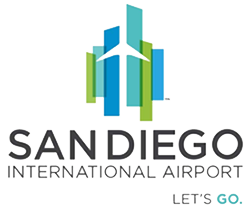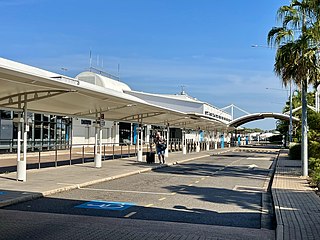
The Consolidated B-24 Liberator is an American heavy bomber, designed by Consolidated Aircraft of San Diego, California. It was known within the company as the Model 32, and some initial production aircraft were laid down as export models designated as various LB-30s, in the Land Bomber design category.

Air America was an American passenger and cargo airline established in 1946 and covertly owned and operated by the Central Intelligence Agency (CIA) from 1950 to 1976. It supplied and supported covert operations in Southeast Asia during the Vietnam War, including providing support for drug smuggling in Laos.

Convair, previously Consolidated Vultee, was an American aircraft-manufacturing company that later expanded into rockets and spacecraft. The company was formed in 1943 by the merger of Consolidated Aircraft and Vultee Aircraft. In 1953, it was purchased by General Dynamics, and operated as their Convair Division for most of its corporate history.

San Diego International Airport is an international airport serving San Diego, California, United States. The airport is located three miles northwest of downtown San Diego. It covers 663 acres (268 ha) of land and is ranked the third busiest airport in California in terms of passenger traffic. It is the busiest single-runway airport in the United States.

Boise Airport is a joint civil-military airport in the western United States in Idaho, three miles (5 km) south of downtown Boise in Ada County. The airport is operated by the city of Boise Department of Aviation, overseen by an airport commission. The busiest airport in the state, it serves more passengers than all other Idaho airports combined and roughly ten times as many passengers as the next busiest airport at Idaho Falls.

The Consolidated C-87 Liberator Express was a transport derivative of the B-24 Liberator heavy bomber built during World War II for the United States Army Air Forces. A total of 287 C-87s were officially delivered from Consolidated Aircraft plant in Fort Worth, Texas. The plant also developed and delivered a USAAF flight engineer trainer designated as the AT-22. The AAF C-87A was an executive transport version of the C-87. The United States Navy VIP transport designated as the RY. The last development was a Navy contracted, single tail version with an extended fuselage. Built in San Diego, its USN designation was RY-3 and the AAF had order the design as the C-87C. Those were cancelled and allotted to a Royal Air Force VIP transport designated as the Liberator C.IX

The Avro York was a British transport aircraft developed by Avro during the Second World War. The design was derived from the Avro Lancaster heavy bomber, several sections of the York and Lancaster being identical. Due to the importance of Lancaster production, York output proceeded slowly until 1944, after which a higher priority was placed upon transport aircraft.

The Avro 691 Lancastrian was a British and Canadian passenger and mail transport aircraft of the 1940s and 1950s developed from the Avro Lancaster heavy bomber. The Lancastrian was basically a modified Lancaster bomber without armour or armament and with the gun turrets replaced by streamlined metal fairings, including a new nose section. The initial batch was converted directly from Lancasters; later batches were new builds.

Gander International Airport is located in Gander, Newfoundland and Labrador, Canada, and is operated by the Gander International Airport Authority. Canadian Forces Base Gander shares the airfield but is a separate entity from the airport. The airport is sometimes referred to as the "Crossroads of the World", and is classified as an international airport by Transport Canada.

Lynden Pindling International Airport, formerly known as Nassau International Airport, is the largest airport in the Bahamas and the largest international gateway into the country. It is a hub for Bahamasair, Western Air, and Pineapple Air. The airport is located in western New Providence island near the capital city of Nassau. The airport is named after Lynden Pindling, the first prime minister of the Bahamas.

Eareckson Air Station, formerly Shemya Air Force Base, is a United States Air Force military airport located on the island of Shemya, in the Alaskan Aleutian Islands.

Darwin International Airport is a domestic and international airport, and the only airport serving Darwin, Australia. It is the eleventh busiest airport in Australia measured by passenger movements.

Willow Run Airport is an airport in Van Buren Charter Township and Ypsilanti Charter Township, near Ypsilanti, Michigan, United States, that serves freight, corporate, and general aviation. Due to its very close proximity to Detroit Metropolitan Airport, no major airlines schedule passenger flights to or from Willow Run. It is included in the Federal Aviation Administration (FAA) National Plan of Integrated Airport Systems for 2017–2021, in which it is categorized as a national reliever airport facility.

Air Transport Command (ATC) was a United States Air Force unit that was created during World War II as the strategic airlift component of the United States Army Air Forces.

The Consolidated Aircraft Corporation was founded in 1923 by Reuben H. Fleet in Buffalo, New York, the result of the Gallaudet Aircraft Company's liquidation and Fleet's purchase of designs from the Dayton-Wright Company as the subsidiary was being closed by its parent corporation, General Motors. Consolidated became famous, during the 1920s and 1930s, for its line of flying boats. The most successful of the Consolidated patrol boats was the PBY Catalina, which was produced throughout World War II and used extensively by the Allies. Equally famous was the B-24 Liberator, a heavy bomber which, like the Catalina, saw action in both the Pacific and European theaters.

The Consolidated PB4Y-2 Privateer is an American World War II and Korean War era patrol bomber of the United States Navy derived from the Consolidated B-24 Liberator. The Navy had been using B-24s with only minor modifications as the PB4Y-1 Liberator, and along with maritime patrol Liberators used by RAF Coastal Command this type of patrol plane was proven successful. A fully navalized design was desired, and Consolidated developed a dedicated long-range patrol bomber in 1943, designated PB4Y-2 Privateer. In 1951, the type was redesignated P4Y-2 Privateer. A further designation change occurred in September 1962, when the remaining Navy Privateers were redesignated QP-4B.

Imeson Field, also known as Jacksonville Imeson Airport, was the airport serving Jacksonville, Florida, from 1927 until its closing in 1968. It was known as Jacksonville Municipal Airport prior to World War II, Jacksonville Army Airfield when the United States Army Air Forces controlled the facility during World War II, and at its closing the airport was Jacksonville – Thomas Cole Imeson Municipal Airport.

British Overseas Airways Corporation (BOAC) was the British state-owned airline created in 1939 by the merger of Imperial Airways and British Airways Ltd. It continued operating overseas services throughout World War II. After the passing of the Civil Aviation Act 1946, European and South American services passed to two further state-owned airlines, British European Airways (BEA) and British South American Airways (BSAA). BOAC absorbed BSAA in 1949, but BEA continued to operate British domestic and European routes for the next quarter century. The Civil Aviation Act 1971 merged BOAC and BEA, effective 31 March 1974, forming today's British Airways.
This is a partial list of notable accidents and incidents involving the Consolidated-designed B-24 Liberator. Combat losses are not included except for some cases denoted by singular circumstances. Consolidated C-87 Liberator Express and PB4Y Privateers are also included.


















